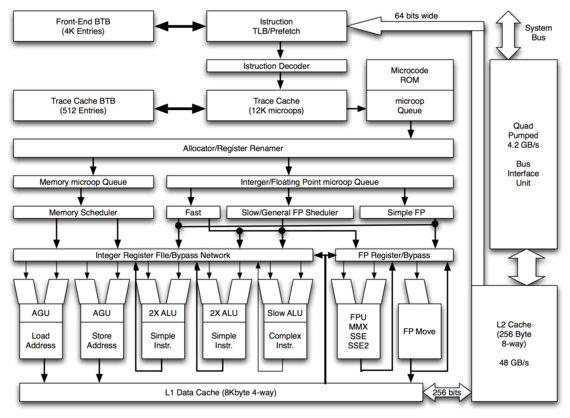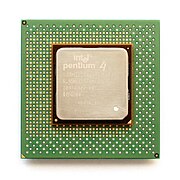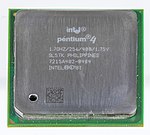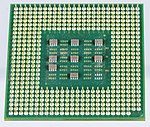Intel Pentium 4
| << Intel Pentium 4 >> | |
|---|---|
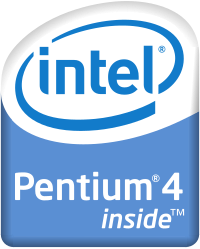 Intel Pentium 4 logo |
|
| Production: | 2000 to 2008 |
| Producer: | Intel |
| Processor clock: | 1300 MHz to 3800 MHz |
| FSB cycle: | 100, 133 and 200 MHz |
| L2 cache size: | 256 KiB to 2 MiB |
| Manufacturing : | 180 nm to 65 nm |
| Instruction set : | IA-32 / Intel 64 |
| Microarchitecture : | NetBurst |
| Base: | |
Names of the processor cores:
|
|
Intel Pentium 4 is a brand name for a range of seventh x86 generation microprocessors .
The first Pentium 4 with the code name Willamette ran with clock frequencies of 1.4 and 1.5 GHz and came on the market in November 2000. The Pentium 4 with the new NetBurst architecture showed only insignificant improvements compared to the older P6 design of the Pentium III in terms of integer and floating point performance. Instead, it focused on two things: high clock frequencies that were aggressively advertised and SSE performance.
Similar to the older Pentium families, the Pentium 4 is also available in a low-cost version called Celeron and a version called Xeon that supports symmetrical multiprocessing . To better distinguish it from the Celeron variants of the Pentium II and Pentium III , the variant derived from the Pentium 4 is often referred to as the Celeron 4. Newer models with Prescott core were named Celeron D sold. As a special feature, Intel had a Pentium 4 Extreme Edition in its program, which was positioned as a high-end CPU against AMD's Athlon 64 FX .
The dual-core CPUs developed on the basis of the NetBurst architecture are sold under the name Pentium D or Pentium Extreme Edition .
Innovations in the Pentium 4 architecture
The Pentium 4 is based on Intel's NetBurst architecture and therefore does less work per cycle than other CPU designs (e.g. Athlon or Pentium III). In return, the P4 has a very long pipeline in order to achieve a high speed primarily via the clock by dividing the command execution as finely as possible. In the event of incorrectly predicted program branches, however, the entire pipeline must be discarded and refilled. The competitor Athlon XP can therefore achieve the same performance as the Pentium 4 with far less clock speed. Another factor why the Pentium 4 has to rely on ever higher clock rates is an old weakness of the Intel floating point unit , which leads to special operations such as zero divisions or calculations where the result is not a meaningful number ( Not a Number, NaN ) or infinite, on the FPU of the Pentium 4 up to 950 times longer than on the AMD Athlon. The problem can be avoided by consistently using the SSE unit for floating point calculations, but many programs on the market are not optimized for this.
Thermal monitoring
With the Pentium 4, Intel introduced an advanced overheating protection called thermal throttling . The overheating protection of the Pentium III led to an immediate emergency shutdown if the processor was insufficiently cooled. With the Pentium 4, this emergency shutdown, which takes effect at a chip temperature of around 125 ° C, is still available. The additional safety function can be used in two operating modes. In automatic mode, the processor inserts work breaks when a temperature dependent on the respective model is exceeded (approximately between 63 and 70 ° C) by switching off the work cycle in a model-dependent pulse-pause ratio. The actual processor clock is not reduced here. The Pentium 4 can also be operated in a configurable mode, in which either the BIOS or the operating system can change the pulse-pause ratio in eight steps down to a minimum of 12.5%.
However, this method is not suitable as an energy-saving mechanism, since the efficiency is not increased, but rather reduced. Thermal throttling is used to protect the processor from heat death. More efficient energy-saving mechanisms such as SpeedStep lower the clock frequency as well as the core voltage and switch off unused parts of the processor and peripheral components, which accounts for a considerable part of the energy savings.
Models
Willamette
The first Pentium 4 suffered from delays in the design process, which allegedly stemmed from the fact that Intel needed many engineers at the same time for the Itanium project and the various variants of the P6 core (Pentium II, III and Celeron). Many experts saw the first P4 processors, which came out with 1.4 and 1.5 GHz in November 2000, as an emergency measure by Intel, since the competing product AMD Athlon Thunderbird had surpassed the aging Pentium III, but only further improvements to the P-III were difficult to do. Willamettes were made in a 180 nm process.
The first Pentium 4 only came close to the performance of the Athlon Thunderbird and even the fastest Pentium III processors at the time in very few tests. The processor initially only sold moderately.
In January 2001 an even lower clocked model with 1.3 GHz was added, which suggested that Intel had great difficulties with the clock stability of the P4 cores at that time. After that, however, Intel was able to quickly compensate for the lead on AMD. In April, Intel brought a P4 with 1.7 GHz, which was clearly faster than the previous Pentium III for the first time. Models with 1.6 and 1.8 GHz followed in July, and from August 2001 Intel started delivering processors with 1.9 and 2.0 GHz.
| CPU speed (MHz) | 1300 | 1400 | 1500 | 1600 | 1700 | 1800 | 1900 | 2000 |
|---|---|---|---|---|---|---|---|---|
| Available for | So423 | So423 So478 |
||||||
| Front side bus | 100 MHz | |||||||
| multiplier | 13 | 14th | 15th | 16 | 17th | 18th | 19th | 20th |
| introduction | Jan. 2001 | Nov 2000 | Jul 2001 | Apr 2001 | Jul 2001 | Aug 2001 | ||
Northwood
In January 2002 Intel brought the Pentium 4 with the new Northwood core onto the market. The Northwood had an L2 cache doubled from 256 KiB to 512 KiB and was manufactured using the new 130 nm process. By building the chip from smaller transistors , it could run faster and still use less energy than its predecessor, which was still manufactured in 180 nm structures. This alleviated the cooling problem of the P4 somewhat, but the leakage currents still required a high level of power.
Two models with 2.0 and 2.2 GHz were presented in January 2002, followed in April by the model with 2.4 GHz. From May you could buy models with 2.53 GHz with the front side bus accelerated to 133 MHz (FSB 533) at the same time , in August the 2.6 and 2.8 GHz clock levels followed, and in November the 3.06 GHz -Model first delivered microprocessors with a clock frequency of over 3 GHz. This top of the line supported Hyper-Threading (first introduced on the Xeon ), which allows the CPU to run two threads at the same time because some parts of the processor are duplicated. For the operating system, such a processor looks like a multiprocessor system and can improve the parallel work with several programs (e.g. virus scanner or 3D game) or multithreading within a process, provided that the programming is appropriate.
In April 2003, Intel brought new variants onto the market that had a clock rate of 2.4 to 3.0 GHz and all of them were capable of Hyper-Threading. They differed from the earlier processors in that their front side bus was operated at 200 MHz (quad-pumped FSB 800). The 3.2 GHz version of the Pentium 4 presented in June 2003 increased the performance lead in most benchmarks even further. The last variant of the Northwood is a Pentium 4 with 3.4 GHz, which came on the market in early 2004.
Prescott
On February 1, 2004, Intel introduced a new P4 core, code-named Prescott . The core is manufactured for the first time in a 90 nm process, supports SSE3 commands and at the same time represents a major overhaul of the microarchitecture of the Pentium 4. The first Prescotts ran at the same clock rate as the Northwood CPUs and benchmarks showed that the Northwood was somewhat more efficient due to the pipeline being extended again at Prescott. The architecture of the Prescott, however, was supposed to allow far higher clock rates than would have been possible with the Northwood core, which had arrived at the end of its life. However, due to leakage currents and an ever increasing amount of waste heat, this plan could not be implemented, the final clock rates were only 400 MHz above that of the fastest Northwood model.
A few months after the introduction of the change from was PGA - socket 478 on the LGA - Socket 775 completed. The main reasons for the introduction of the new LGA socket are on the one hand the more favorable high-frequency properties of the metal knob contacts and on the other hand the higher possible pin density. With the Socket 775 models of the Prescott, compared to the Socket 478 models, there is an overall slightly higher heat development, which could only be countered with the revised boxed coolers with an inserted copper core. It is thanks to this slightly better cooling concept that the temperatures could still be reduced. Subsequent revisions of the processor by Intel's engineers have meanwhile ensured that energy consumption and heat emission come back closer to the values of the Northwood core.
With the introduction of the LGA775 Prescotts, Intel switched to a new rating-based model numbering scheme in which the Prescotts run as the 5xx series (Celerons are the 3xx series, Pentium M and Extreme Editions are part of the 7xx series). The fastest published Prescott processor is the 570J clocked at 3.8 GHz. It was the first Pentium 4 processor to support Intel's Execute-Disable-Bit ( XD-Bit ), a technology taken over by AMD under the patent exchange agreement, which is called NX-Bit in the Athlon 64 . The J appended to the type designation indicates this function . The plans for 4 GHz processors were abandoned by Intel in favor of dual core processors and the Intel core microarchitecture . The 600 series with the Prescott 2M core was introduced as an intermediate step and way out of the “gigahertz trap”. The most important feature is the L2 cache enlarged to 2048 KiB and the implementation of additional technologies such as Intel 64 and the Intel VT virtualization technology , which was only officially activated in the third quarter of 2005. It does not yet achieve the high clock rates of the classic Prescott and the gain in performance compared to the models of the 500 series is rather low. But this model shows Intel's new strategy, away from high clock rates that are effective for advertising, towards larger caches and technical innovations.
Cedar Mill
Cedar Mill is basically a Prescott 2M made in 65 nm and also has its features and functions. The CPU appeared in early 2006 and is the last CPU in the Pentium 4 series.
future
With the replacement of the NetBurst architecture , Intel also phased out the Pentium 4. The very well-known brand name "Pentium" is only continued with the Pentium Dual-Core , which has nothing to do with the Pentium 4 technically.
Model data
Willamette
- L1 cache: 8 KiB (data) plus 12,000 µOps (decoded instructions)
- L2 cache: 256 KiB with processor clock
- MMX , SSE , SSE2
- Socket 423 and Socket 478 , AGTL + with 100 MHz Front Side Bus (quadpumped, FSB 400)
- Operating voltage ( VCore ): 1.75 V.
- Power Dissipation ( TDP ): 48.9-75.3 watts
- Release DATE: November 2000
- Manufacturing technology: 180 nm
- Die size: 217 mm² with 42.0 million transistors
- Clock rates: 1.30–2.00 GHz
- Socket 423: 1.30–2.00 GHz (100 MHz steps)
- Socket 478: 1.40–2.00 GHz (100 MHz steps)
Northwood
- L1 cache: 8 KiB (data) plus 12,000 µOps (decoded instructions)
- L2 cache: 512 KiB with processor clock
- MMX , SSE , SSE2 , partially Hyper-Threading (3.066 MHz and C models)
- Socket 478 , AGTL + with 100, 133 and 200 MHz Front Side Bus (quadpumped, FSB 400/533/800)
- Operating voltage ( VCore ): 1.53 V.
- Power loss ( TDP ): up to 89 watts
- Release DATE: Jan. 7, 2002
- Manufacturing technology: 130 nm
- Die size: 146 mm² / 131 mm² with 55.0 million transistors
- Clock rates: 1.60-3.40 GHz
- 100 MHz FSB: 1.60, 1.80, 2.00, 2.20, 2.40, 2.50, 2.60, 2.80, 3.00 GHz
- 133 MHz FSB (B models): 2.26, 2.40, 2.53, 2.66, 2.80, 3.06 GHz
- 200 MHz FSB (C models): 2.40, 2.60, 2.80, 3.00, 3.20, 3.40 GHz
Prescott
- L1 cache: 16 KiB (data) plus 12,000 µOps (decoded instructions)
- L2 cache: 1024 KiB with processor clock
- MMX , SSE , SSE2 , SSE3 , Intel 64 (F and 5x1 models), XD-Bit (F and J models), Hyper-Threading (Socket 478 CPUs and 5x0 / 5x1 models)
- Socket 478 and LGA775 , AGTL + with 133 and 200 MHz Front Side Bus (quadpumped, FSB 533/800)
- Operating voltage ( VCore ): 1.25-1.4V
- Power dissipation ( TDP ): 84 to 115 watts
- Original Release Date: February 2, 2004 (Socket 478), June 21, 2004 (Socket 775)
- Manufacturing technology: 90 nm
- The size: 112 mm² with 125.0 million transistors
- Clock rates: 2.26-3.80 GHz
- Clock rates for socket 478 :
- 133 MHz FSB:
- 2.26 GHz (only 512 KiB L2 cache)
- 2.40 GHz
- 2.80 GHz (no HTT )
- 200 MHz FSB:
- 2.80 GHz
- 3.00 GHz
- 3.20 GHz
- 3.40 GHz
- 133 MHz FSB:
-
Model numbers for socket 775 : The list of supported functions differs from the usual nomenclature for the processor group with 133 MHz FSB. For details see here .
- 133 MHz FSB:
- 505 (J), 506: 2.66 GHz
- 511: 2.80 GHz
- 515 (J), 516, 517: 2.93 GHz
- 519 (F), 524: 3.06 GHz
- 200 MHz FSB:
- 520 (J), 521: 2.80 GHz
- 530 (J), 531: 3.00 GHz
- 540 (J) (F), 541: 3.20 GHz
- 550 (J) (F), 551: 3.40 GHz
- 560 (J) (F), 561: 3.60 GHz
- 570J, 571: 3.80 GHz
- 133 MHz FSB:
- Clock rates for socket 478 :
Prescott 2M
- L1 cache: 16 KiB (data) plus 12,000 µOps (decoded instructions)
- L2 cache: 2048 KiB with processor clock
- MMX , SSE , SSE2 , SSE3 , Intel 64 , EIST , XD-Bit , IVT (only 6x2 models), Hyper-Threading
- LGA775 , AGTL + with 200 MHz Front Side Bus (quadpumped, FSB 800)
- Operating voltage ( VCore ): 1.4V
- Power loss ( TDP ): 84 watts (up to 650), 115 watts (from 660)
- Release DATE: February 2005
- Manufacturing technology: 90 nm
- Die size: 135 mm² with 169.0 million transistors
- Clock rates: 2.80-3.80 GHz
-
Model Numbers :
- 620: 2.80 GHz
- 630: 3.00 GHz
- 640: 3.20 GHz
- 650: 3.40 GHz
- 660: 3.60 GHz
- 662: 3.60 GHz
- 670: 3.80 GHz
- 672: 3.80 GHz
Cedar Mill
- L1 cache: 16 KiB (data) plus 12,000 µOps (decoded instructions)
- L2 cache: 2048 KiB with processor clock
- MMX , SSE , SSE2 , SSE3 , Intel 64 , EIST , XD-Bit , Hyper-Threading
- LGA775 , AGTL + with 200 MHz Front Side Bus (quadpumped, FSB 800)
- Operating voltage ( VCore ): 1.200-1.325 V.
- Power dissipation ( TDP ): 65, 80 or 86 watts
- Release DATE: January 5, 2006
- Manufacturing technology: 65 nm
- Die size: 81 mm² with 188.0 million transistors
- Clock rates: 3.00–3.60 GHz
-
Model Numbers :
- 631: 3.00 GHz
- 641: 3.20 GHz
- 651: 3.40 GHz
- 661: 3.60 GHz
Logos
Old logo of the Intel Pentium 4 with Hyper-Threading
New logo of the Intel Pentium 4 with Hyper-Threading
swell
- ↑ Heise online report - "Goodbye Netburst"
- ^ Analysis by Cygnus Software
- ↑ http://techreport.com/review/3289/pentium-4-northwood-2-2ghz-vs-athlon-xp-2000
